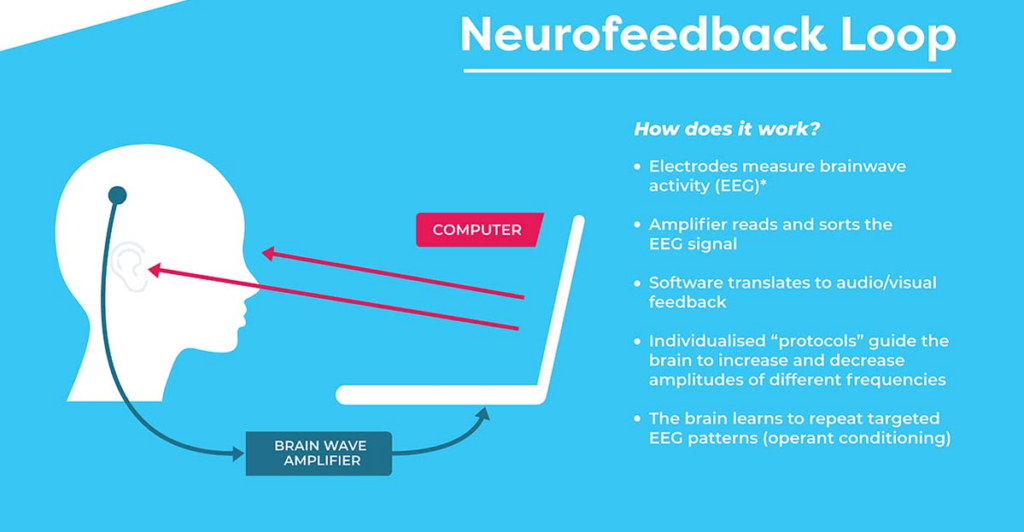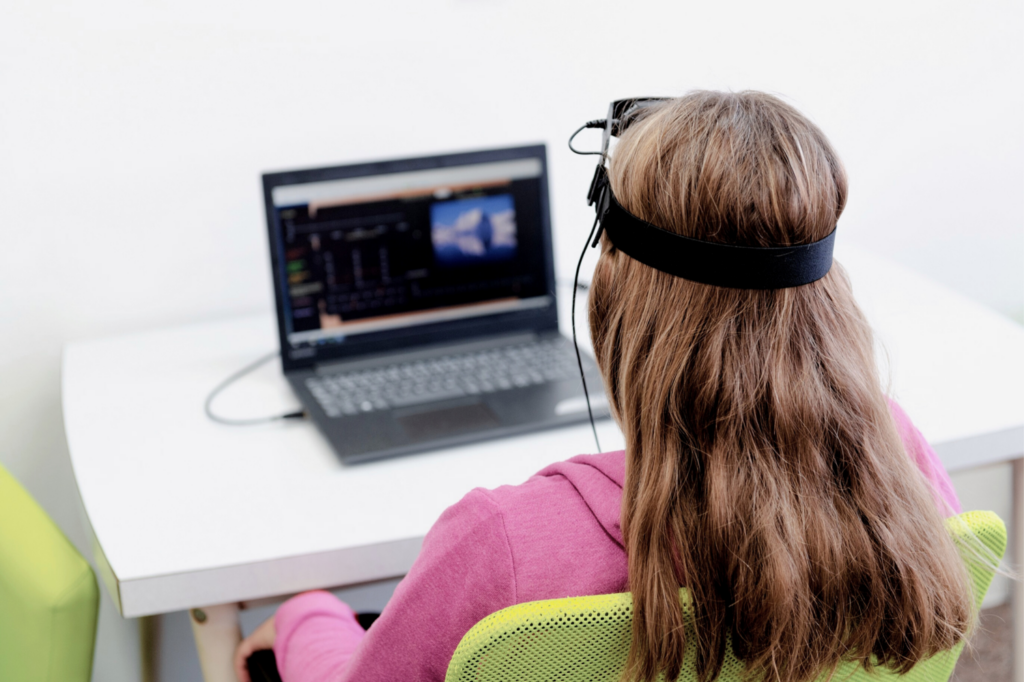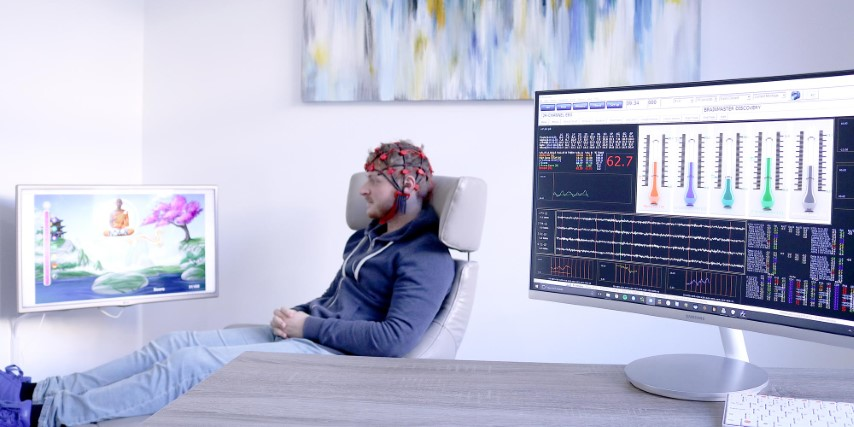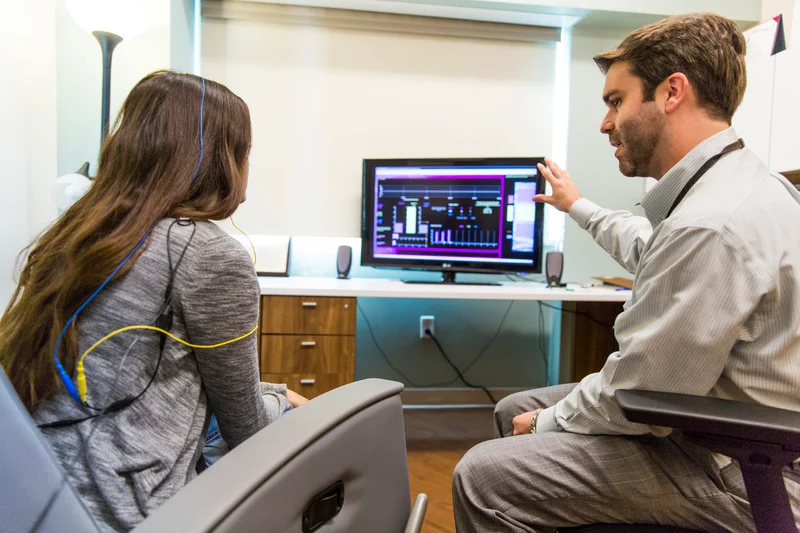Neurofeedback-Biofeedback
Neurofeedback is fundamentally based on operant conditioning. People can learn to identify and manipulate patterns formed by their brainwaves.

Anxiety is a form of mental health issue that affects millions of people around the world. So this has prompted researchers to look for different ways of treating this condition. One such healing approach that has been gaining recognition is neurofeedback. Learn what it is, its process, and its limitations.
What is Neurofeedback?
Neurofeedback is a therapy that trains individuals to self-regulate brain activity using real-time feedback, improving mental and emotional health.
Neurofeedback (also called EEG biofeedback) is a non-invasive method that aims at training the brain to work more efficiently. It involves monitoring brain activity with electroencephalography (EEG) and giving immediate feedback to the person under study.
The aim is to enable individuals to learn how to control their brain waves leading potentially to improved states of mind.
What Is The Science Behind Neurofeedback and Anxiety?
Neurofeedback trains the brain to reduce anxiety by normalizing brainwave patterns, promoting relaxation, and enhancing emotional regulation through real-time feedback.
A number of studies have examined the effectiveness of neurofeedback in managing anxiety disorders.
The Brain’s ability to remodel neural links and accommodate novel experiences is called brain plasticity. People may facilitate the growth of neural pathways of relaxation and emotional control through brainwave exercises and self-regulation.
Sympathetic nervous system gives rise to fight-flight response. This healing modality can assist in balancing autonomic functions towards a more relaxed state.
Some investigation suggests normalization of cortical arousal levels through neurofeedback can help with anxiety disorders.
However, it should also be noted that these results are encouraging but there is need for more large scale controlled studies to conclusively determine the efficacy.
What Are The Benefits of Neurofeedback for Anxiety?
Neurofeedback for anxiety can improve emotional regulation, reduce symptoms, enhance relaxation, and promote long-term mental well-being without medication.
Unlike drug-based therapies, this therapy does not introduce chemicals into one’s system, resulting in minimal side effects. Certain positive effects related to anxiety last even after they stop going for sessions on neurofeedback.
It addresses brainwave patterns peculiar to each person using customized protocols on neuro-feedbacking to anxiety symptoms. This technique enables someone suffering from panic attacks to become an active participant in their therapy, thereby increasing their control over their own fearfulness, worry, phobias, and obsessions.
What Are Its Limitations and Considerations?

Limitations of neurofeedback for anxiety include variability in individual responses, the need for multiple sessions, high costs, and limited availability. Considerations include finding a qualified practitioner and combining it with other treatments.
The effectiveness of this treatment is time-consuming and costly. So, multiple sessions are typically required over a long period. Different individuals react differently to neurofeedback. While some may display considerable advancements, others may experience no alterations.
Neuro-feedback as an anxiety treatment does not have any definite procedure. This might result in different approaches to treating anxiety. Though studies have shown positive short-term results, further research needs to be done.
Several insurance plans exclude coverage for these treatments. This makes it unavailable for many patients.
obsessions.
Can One Compare Between Neurofeedback And Other Anxiety Treatments?
Neurofeedback offers a non-invasive, medication-free approach, while other anxiety treatments may include medication, therapy, or a combination.
To help determine if neurofeedback is worth considering as an option for treating anxiety, one must consider other established approaches:
Anxiety medications work fast but come with side effects and dependency risks. This alternative method does not have these drawbacks since it deals with the underlying reasons.
This is a method used to help people with anxiety disorder. Neuro-feedback fills in areas that CBT cannot address by defining the physiology of brain waves in anxiety.
Similar to neural feedback, these help increase self-awareness and relaxation. In comparison with mindfulness or meditation techniques, however, neural feedback can improve brain wave activities directly and quickly.
Regular physical exercise has been proven effective at reducing symptoms of anxiety. For example, bio-functioning models enhance the treatment and management of anxiety.
What Is The future of neurofeedback?
The future of neurofeedback includes advanced technology, broader accessibility, integration with other therapies, and increased recognition in mental health treatment.
The use of more sophisticated forms of brain imaging may result in a more accurate and effective treatment protocol. Creating user-friendly, at-home neurofeedback devices could make this treatment more available and convenient.
More comprehensive and effective anxiety management strategies can be discovered through further investigations and combined with this healing modality.
If AI-driven analysis is employed in relation to EEG data, it might help personalize the treatment and predict individual responses better.
Why is Neurofeedback Controversial?

Neurofeedback is controversial due to mixed research results, high costs, varying practitioner qualifications, and debate over its long-term effectiveness.
Neurofeedback is a source of controversy because of inconsistent scientific support. Critics claim that its mechanisms are not well understood and that placebo effects might be significant. In addition, the lack of standardized protocols and variations in practitioners’ training and methodologies undermine the trust factor.
Some critics also argue that the high cost associated with it creates doubts about its effectiveness. It seems too promising so people become skeptical about it.
Why do I feel worse after Neurofeedback?
Feeling worse after neurofeedback can occur due to brain adjustments, incorrect protocols, or overtraining, and usually resolves with proper guidance.
Some people might feel worse after this treatment as a result of maladaptive training protocols whereby brain activity is misregulated rather than optimized. Moreover, initial sessions could lead to temporary side effects such as tiredness, anxiety, or headaches during brain adjustment periods for new patterns.
Such negative reactions suggest possible adjustments in the frequency or intensity of sessions. Hence, the therapist should be informed immediately. Clinicians can then match your treatment plan with your specific needs for better results.
What is the role of neurofeedback therapy?
Neurofeedback therapy trains the brain to self-regulate, improving mental health conditions like anxiety, ADHD, and depression through real-time feedback.
In this therapy, patients are trained to regulate their own brainwave patterns through real-time feedback. This process involves recording a person’s brain activity using EEG sensors and giving them visual or auditory cues that help them shift their brainwaves in specific ways.
The purpose of this technique is to restore more normal and efficient operation of the brain to treat conditions like ADHD, anxiety, depression, and sleep disorders. Eventually, a person may gain more control over themselves emotionally and mentally without any external aid.
Conclusion
Though neurofeedback as a treatment for anxiety holds hope, it’s not a one-size-fits-all solution, nor is it a guaranteed healing modality. It works differently for different people. So, further studies are required to learn about its long-term effects. However, anyone interested in managing anxiety without using drugs or invasive procedures can look into this alternative approach as part of their treatment plan.
References
Neurofeedback-Biofeedback
Neurofeedback is fundamentally based on operant conditioning. People can learn to identify and manipulate patterns formed by their brainwaves.

Biofeedback undeniably is a powerful self-regulation and wellness tool when considered alongside modern health interventions. They target personal health improvement but do so at different physiological levels and for various therapeutic reasons. This blog will explore what they are made of, where they can be used, and how each contributes to the management of health.
What is Biofeedback?
Biofeedback is a training technique that educates the human mind to self-regulate specific physiological processes such as heart rate, muscle tension, and blood pressure based on real-time feedback, thereby increasing health and performance through awareness and voluntary regulation.
For instance, anxiety responds better to biofeedback treatment than any other therapy because, in that case, patients learn to regulate their response to stress while treatment plans involving methods that rely on muscle relaxation to reduce pain are considered for the treatment of chronic pain.
Except for them, athletes also use it so as to better performances by improving physiological manipulation of systems in play or exercise while musicians deploy the same to optimize their playing skills based on feedback received about Tempo among others.

What is Neurofeedback?
Neurofeedback is a therapeutic technique that trains the brain to self-regulate by monitoring brainwave activity. It helps improve mental health conditions such as ADHD, anxiety, and depression through real-time feedback and reinforcement of healthier brain patterns.
Neurofeedback is all about the electrical activity of the brain which is tracked and displayed through the use of EEG technology. It shows individuals how to change their brain waves in order to improve mental function and reduce neurological symptoms. ADHD can be treated with neurofeedback as it helps to increase attention while depression and anxiety are reduced through relaxation promoted by this method.
Moreover, sleep disorders are managed by altering brain wave patterns so that healthy sleep cycles may be induced. Additionally, it assists in rehabilitating cognitive functions impaired by trauma during recovery from traumatic brain injury.

How does neurofeedback work in the brain?
Neurofeedback works in the brain by training individuals to alter brainwave activity by providing real-time feedback using EEG technology. It helps in managing conditions like ADHD, anxiety, and PTSD by promoting healthier brainwave patterns.
It improves cognitive function and brings emotional balance. During a neurofeedback session, a trained professional will walk the user through the process, allowing them to watch their brain wave activity and learn to control it so that, overtime, clear metal clarity, emotional resilience, and a better focus can be gained. It gives real-time feedback to help the participant recognize and reinforce the desirable patterns of brainwaves. This enables permanent changes in brain function and reduces symptoms of many psychological disorders.
What are the common uses of biofeedback?
Biofeedback is commonly used to treat stress, anxiety, chronic pain, and hypertension. It involves monitoring bodily functions like heart rate and muscle tension to encourage relaxation and self-regulation.
Patients learn to identify the responses to stress and modify them appropriately. This can enhance physical health and alleviate symptoms. Biofeedback allows the client to apply such techniques as deep breathing or progressive muscle relaxation after their physiological states have been enhanced, thus resulting in reduced stress and increased control over physical and emotional well-being.
This form of therapy makes the individual aware of the interplay between the state of their mind and physical health, thus enforcing proactive management and reduction of symptoms of stress and related conditions through regular practice and feedback.
How Successful Can Neurofeedback Therapy Be?
The success rates for neurofeedback therapy vary greatly depending on the skill of the practitioner, the level of patient participation, and the type of condition being treated. Its effectiveness is backed by research, primarily in terms of addressing behavioral symptoms related to ADHD and alleviating anxiety.
There are many accounts from patients themselves or those who have worked with them in a clinical setting that describe profound changes following treatment. This recognition has contributed significantly towards increasing its use throughout different medical communities. Nevertheless, people must have realistic expectations and know-how grounded scientifically so they don’t get misled about what can or cannot happen through this form of therapy.

What Disorders Does Neurofeedback Treat?
Neurofeedback helps treat disorders such as ADHD, anxiety, depression, PTSD, and sleep disorders. By training the brain to self-regulate, it improves mental health and cognitive function, offering a non-invasive, drug-free therapy option.
The range for applying neurofeedback is wide because it treats disorders by modifying brain activities at their foundation. Specifically, attentional control is improved during treatment for ADHD while stabilizing fluctuations in moods may help alleviate anxiety along with depression.
Sleep problems and learning disabilities are also targeted by normalizing waveforms associated with restfulness or wakefulness within various areas across our mindscape. Understanding individual brain mechanisms remains key to successful customization according to needs when engaging in such treatments.
Is neurofeedback scientifically proven to be effective?
Research supports neurofeedback’s effectiveness for conditions like ADHD, anxiety, and PTSD, showing positive outcomes in numerous studies. While results vary among individuals, many experience significant improvements in symptoms.
Neurofeedback is often utilized in conjunction with other treatments to yield the best possible results. Research into its further applications is ongoing. For example, neurofeedback is able to reduce the level of anxiety and improve attention in patients with ADHD; it has also been shown that neurofeedback enables long-term changes in brain activity, which makes it a very promising additional treatment in complex therapy schemes.
While this may vary in experience, neurofeedback does show promise in improving general well-being, and the application is on the increase as continued research validates its effectiveness in improving various neurological and psychological ailments.
In Conclusion
Biofeedback and neurofeedback help one improve their health individually by providing various ways through which they can deal with different conditions. They work best if only we understand how they work and use them appropriately whenever necessary. To achieve this people should seek advice from experienced professionals who will guide them on what steps need to be taken during treatment so that it becomes effective. Hence, this proves that indeed healthcare should always be tailored according to each person’s needs thereby making life better for all individuals within the society.
Neurofeedback-Biofeedback
Neurofeedback is fundamentally based on operant conditioning. People can learn to identify and manipulate patterns formed by their brainwaves.

Neurofeedback is an advanced technology that uses brain waves to increase brain activity by monitoring them and providing feedback immediately. It is called “brain rewiring” because it alters the thinking patterns and emotions to improve mental health. Understanding how these pathways are affected by neurofeedback is critical in understanding its potential benefits for mental well-being.
What is neurofeedback, and how does it work?
Neurofeedback trains the brain to enhance function by monitoring and adjusting brainwave activity in real-time, leading to improved mental health and cognitive performance.
Neurofeedback is the use of a biofeedback technique that trains the brain to function better. It is a process where activity in a person’s brain is monitored, which ultimately helps the user learn to self-regulate his or her brain waves.
An individual can control brainwave patterns through neurofeedback by visual or auditory clues to guide them to any mental state they desire, thus improving focus and relaxation, leading to enhancement of cognitive performance.
The electrodes are applied to the scalp, and the client views a computer screen with the brainwaves showing in order to have self-regulation and neuroplasticity control.
Can neurofeedback rewire your brain effectively?
Neurofeedback promotes neuroplasticity, effectively rewiring the brain by forming new neural connections, enhancing emotional regulation, and improving cognitive functions.
Neurofeedback enhances the efficiency of rewiring the brain by increasing neuroplasticity, a process through which the brain forms new neural connections.
It helps in improving one’s emotional regulation and cognitive functions by training the brain to invent new activity patterns. After several sessions, some long-lasting changes could be achieved with special benefits for conditions like ADHD, anxiety, and PTSD.
Through the regulation of brainwaves, better flexibility and the processing of the brain can be done in information and emotions.
What are the benefits of neurofeedback therapy?
Neurofeedback therapy offers benefits like improved attention, reduced anxiety, better emotional regulation, and enhanced sleep, aiding in the management of ADHD and depression.
This kind of therapy has many benefits associated with it, such as attention improvement, anxiety reduction, regulation of emotional states, and improved sleep. It is highly effective in the symptomatic management of attention-deficit/hyperactivity disorder and depression.
Neurofeedback accomplishes this by training your brain to function more effectively, enabling long-term positive effects on your mental health. It enhances memory, focus, and relaxation and is a very individualized way of training the brain for self-regulation and performance improvement.

How does neurofeedback help with anxiety and stress?
Neurofeedback helps manage anxiety and stress by training the brain to maintain a calm state and adjust brainwave patterns associated with stress, improving resilience and emotional stability.
Neurofeedback helps in anxiety and stress by teaching the brain how to remain calm and balanced. It is training a person to recognize and change their brain wave pattern that results in stress.
The process reduces symptoms of anxiety and increases resilience, leading to better stress management and emotional stability.
Neurofeedback provides real-time feedback regarding brain activity and enables individuals to develop adaptive coping strategies to deal with anxious feelings, thereby obtaining better control over their emotional responses.
Is neurofeedback safe for children with ADHD?
Neurofeedback is a safe, non-invasive therapy for children with ADHD, helping improve attention, reduce impulsivity, and enhance focus without medication.
Neurofeedback is considered safe for children with ADHD, and it offers a non-invasive and non-medicated approach to controlling the symptoms of ADHD. The therapy works by enhancing the attention process through the reduction of impulsiveness and increasing focus by training the brain to work more effectively.
Many parents have thus found this to be a real alternative to medication. Neurofeedback helps children learn to concentrate and curb impulsive behaviors during sessions tailored to each child’s needs, complementing other treatments aimed at ADHD and rewarding desirable patterns of brainwaves.

How long does it take to see results from neurofeedback?
Results from neurofeedback vary; some notice changes after a few sessions, while others may need 20-40 sessions. Consistent practice is crucial for achieving lasting benefits.
The timeline to derive results from neurofeedback is wide-ranging. While some report improvement after a few sessions, others may need 20-40 sessions. Of course, this depends on the individual goals, as well as the severity of symptoms.
Benefits might at first include improved focus or decreased anxiety, and then more pervasive changes happen when the brain becomes more efficient at self-regulation. Regular sessions and ongoing practice are necessary to strengthen and maintain the neural pathways in the brain.
What conditions can neurofeedback treat effectively?
Neurofeedback effectively treats conditions like ADHD, anxiety, depression, PTSD, and sleep disorders and also supports cognitive enhancement and performance optimization.
It is also possible to work on attention deficit hyperactivity disorder, anxiety, depression, PTSD, sleep disorders, and cognitive enhancement/performance optimization.
Basically, neurofeedback works by improving symptoms and enhancing overall brain functioning by targeting specific brainwave patterns. In view of the ability to create neuroplasticity in the brain, it turns out to be valuable in matters that deal with mood, attention, and stress-related issues.
Treatment is individualized according to needs, hence providing an individualistic approach to mental health care that supports long-term recovery and well-being.
Are there any risks associated with neurofeedback?
Neurofeedback is generally safe with minimal risks. Some may experience temporary fatigue or headaches, but side effects are usually mild and resolve as the brain adjusts.
It is generally considered to be safe; there are very few risks associated with neurofeedback. Some people may report temporary fatigue or headaches as side effects, although generally these issues are very mild and go away quite quickly as the brain becomes adjusted to the training.
Working with a qualified professional ensures proper protocols are followed, thus minimizing possible adverse effects. Some people might be emotionally hypersensitive during the period of adjustment, but that happens quite rarely. Clearly communicating with practitioners helps in managing and mitigating potential concerns,
Conclusion
To sum up, the brain’s neuroplasticity can be redefined by neurofeedback and open new mental health avenues. We would advise seeking guidance from a skilled professional if you are contemplating this promising approach. It is our aspiration that it will take its place among the basic requirements of brain care and therapy which will make one’s life better by exploiting the brain plasticity in humans.
